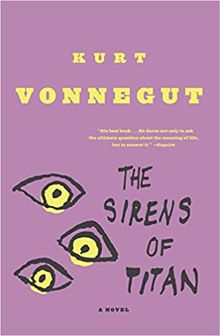Born in 1903 in Warwickshire, England, John Wyndham Parkes Lucas Beynon Harris began publishing science fiction stories under a variety of combinations of his name in the pulps starting in Wonder Stories in 1931. He became one of the leading British sci-fi writers of the 1950s, when he published some of his most acclaimed works, including his two best-known novels, The Day of the Triffids and The Midwich Cuckoos, both of which have been adapted to film numerous times.
By 1950, the so-called “Golden Age of Science Fiction” had drawn to a close, but many of the writers who had made it the Golden Age were still producing work that would come to define the genre. Though the pulps were dying, sci-fi novels and movie adaptations were growing in popularity, and there are those, such as author and editor Robert Silverberg, who regard the 1950s as the “true Golden Age.”
Exciting new writers were also making their voices heard in the 1950s, and the optimism that had defined much early sci-fi writing was gradually being replaced with a growing cynicism that prefigures the New Wave which would grip science fiction beginning in the 1960s. From alien invasions and dystopian futures to post-apocalyptic nightmares, these stories are “not your grandfather’s” sci-fi of rocket ships and ray guns, and these novels showcase some of the best writing that was being done in the genre in the 1950s.

The Day of the Triffids
The first novel that John Wyndham published under that particular pen name, The Day of the Triffids was originally released in 1951 and quickly became Wyndham’s most popular and best-remembered book. It tells of an apocalyptic event in which a meteor shower blinds most of the world’s inhabitants, who then find themselves the victims of aggressive carnivorous plants (the triffids of the title).
The Day of the Triffids was nominated for an International Fantasy Award and has been adapted to film several times, first in 1962, and has inspired countless other works, with screenwriter Alex Garland citing it as a specific influence on the script for his zombie film 28 Days Later.

Foundation
Originally published as short stories in Astounding Science Fiction, the tales that would eventually make up Foundation (and later Asimov’s Foundation series, which would ultimately expand to some seven books) chart the collapse of the first Galactic Empire and the rise of the second, and the work performed by a “psychohistorian” named Hari Seldon to try to preserve the most important aspects of galactic civilization for posterity.
The first three books in what were then dubbed the “Foundation trilogy” won the Hugo Award for Best All-Time Series in 1966 and have gone down in history as some of the greatest sci-fi books ever written.

Childhood's End
First published in 1953, this “first-rate tour de force” (New York Times) became Arthur C. Clarke’s breakout novel and is still often considered his best. It tells of an Earth that is visited by seemingly benevolent aliens called Overlords who guide humanity into what appears to be a utopian age, only to see that it may actually mean the end of humans as a species.
The novel was expanded from a short story that Clarke first published in 1951, and it quickly became regarded as a classic of alien literature that remains startling and powerful to this day.

Fahrenheit 451
Ray Bradbury’s most popular and widely-read book is undoubtedly this dystopian meditation on a world where books are illegal and “firemen” burn any that are found. Since its original publication in 1953, Fahrenheit 451 has served as a metaphor and parable for any number of possible real-world issues, from actual book burning and censorship to a cautionary tale about television and mass media. Whatever it’s about, Fahrenheit 451 joins such novels as Orwell’s 1984 and Huxley’s Brave New World as the blueprint of the dystopian science fiction novel.

More Than Human
Winner of the International Fantasy Award, More Than Human has been regularly hailed as one of the greatest sci-fi novels ever written since its publication in 1953. The novella from which it was expanded was named one of the five “Greatest Science Fiction Novellas of All Time” by the SFWA.
The story concerns a group of individuals with unique powers including telepathy and teleportation, who are able to combine themselves into a single sort of gestalt consciousness, which may just be the next stage of human evolution. Read it to see why Stephen King called Sturgeon “one of the greatest writers of science fiction and fantasy who ever lived.”

I Am Legend
If The Day of the Triffids had a massive impact on the shape of post-apocalyptic pop culture, perhaps no other single work set the template for the subgenre as completely as Richard Matheson’s 1954 classic. I Am Legend, which tells the story of a world overrun by vampires, has been directly adapted into three films, beginning with 1964’s The Last Man on Earth, and was a partial inspiration for George Romero’s genre-defining classic Night of the Living Dead.
By the time I Am Legend saw publication, Matheson had already made a splash as a short story writer, and he would go on to pen dozens of screenplays and Twilight Zone episodes.

The Sirens of Titan
Vonnegut may be best known for his 1969 novel Slaughterhouse-Five, but as early as his second novel, The Sirens of Titan, which was first published in 1959, it’s already “all there, all at once. Kurt Vonnegut has become Kurt Vonnegut,” as William Deresiewicz wrote in a 2012 retrospective on the author’s work.
The Sirens of Titan was a nominee for the Hugo Award, has been hailed by Douglas Adams as an “absolute tour de force,” and was once licensed for adaptation by the Grateful Dead’s Jerry Garcia. It’s also an unforgettable book about free will, omniscience, and the Martian invasion of Earth.
Featured image: Diane Picchiottino / Unsplash



